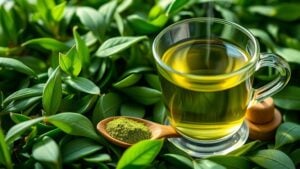Caffeine can be a tricky topic, particularly when it comes to green tea. Many individuals turn to green tea for a gentler lift compared to coffee. The caffeine content varies widely, influenced by the type of tea and how it’s made. From high-caffeine varieties like matcha to low-caffeine options such as hojicha, grasping these differences can help individuals pick the right cup for their needs. So, what exactly should one know about the caffeine scene in green tea?
Understanding Caffeine and Its Effects on the Body
When it comes to deciphering caffeine and its effects on the body, one might wonder how this common stimulant functions. Caffeine, a naturally present compound in green tea, typically furnishes 30-50 mg per 8 oz cup.
It acts by obstructing adenosine receptors, which assists in reducing fatigue while amplifying alertness for three to five hours post-consumption.
The exclusive caffeine quantity in green tea synergizes with L-theanine, crafting a state of concentrated energy devoid of typical coffee-induced agitation. This restrained intake, up to 400 mg daily, could support cognitive operation and boost physical endurance.
Still, immoderate consumption may prompt adverse effects like insomnia, headaches, or elevated heart rate, especially among sensitive individuals.
Caffeine Content in Green Tea
While examining the caffeine content in green tea, it’s intriguing to observe how this pleasant beverage manages to strike a balance between offering a mild lift of energy and encouraging relaxation. Typically, green tea contains 30-50 mg of caffeine per 8 oz cup, providing a gentle uplift compared to coffee. Remarkably, Matcha can deliver 70-130 mg due to its whole-leaf nature, while shaded varieties like Gyokuro can reach 120-140 mg. In contrast, Hojicha, which undergoes roasting, offers less than 20 mg. Factors like brewing time and water temperature substantially influence caffeine extraction.
| Type | Caffeine Content (mg per 8 oz) |
|---|---|
| Green Tea | 30-50 |
| Matcha | 70-130 |
| Gyokuro | 120-140 |
| Hojicha | <20 |
| Coffee | 95-200 |
High-Caffeine Green Teas vs. Low-Caffeine Green Teas
At the time of selecting a green tea, the caffeine content frequently plays a crucial role in shaping the experience. High-caffeine green teas, such as Matcha and Gyokuro, offer strong caffeine levels, with Matcha containing up to 136mg and Gyokuro ranging from 120-140mg per 8oz serving, largely due to their shaded growing conditions. Additionally, brewing time can influence the caffeine extraction, with longer steeping typically resulting in higher caffeine levels. In contrast, low-caffeine green teas like Hojicha provide under 20mg per cup, attributed to its roasting process. Sencha falls in the mid-range with 27-41mg, while Kukicha, made from stems and twigs, is milder, offering less stimulating effects. Grasping these differences can help consumers tailor their tea choices based on their desired caffeine intake and experience.
Comparing Green Tea and Coffee Caffeine Levels
Green tea and coffee often take center stage in conversations about caffeine, as each beverage offers unique experiences and benefits. An average 8-ounce cup of green tea contains about 28 mg of caffeine, whereas brewed coffee boasts around 96 mg.
Importantly, certain high-caffeine green teas, like Gyokuro, can reach caffeine levels of 120-140 mg per serving, rivaling standard coffee. While typically one-third of coffee’s caffeine content, selected green teas such as Matcha can even exceed coffee’s caffeine levels.
Additionally, the absorption of caffeine from tea compared to coffee differs markedly; the presence of L-theanine in green teas moderates its stimulant effects, creating a more balanced experience. Therefore, grasping the subtleties of caffeine levels is vital for enthusiasts.
Health Benefits and Downsides of Caffeine in Green Tea
Caffeine from green tea offers a blend of benefits and drawbacks, making it an intriguing choice for many. This beverage boosts alertness and cognitive performance, complemented by L-theanine, which mitigates jitters often associated with caffeine. Moderate intake can raise metabolism, aiding weight loss through increased fat oxidation.
However, excessive consumption might lead to negative side effects such as insomnia and anxiety, particularly in sensitive individuals or if paired with other stimulants. Importantly, shaded green teas like matcha contain higher caffeine levels while still providing antioxidant benefits. Therefore, while green tea can energize and improve mental functioning, it is vital to consume it mindfully, balancing the health benefits against potential drawbacks to maximize enjoyment and wellness. Additionally, those with existing health conditions should monitor their intake to minimize risks of adverse side effects.


